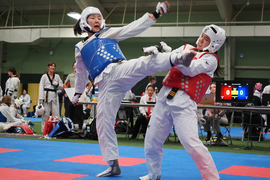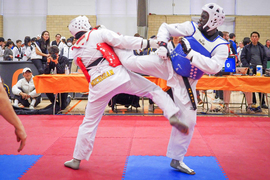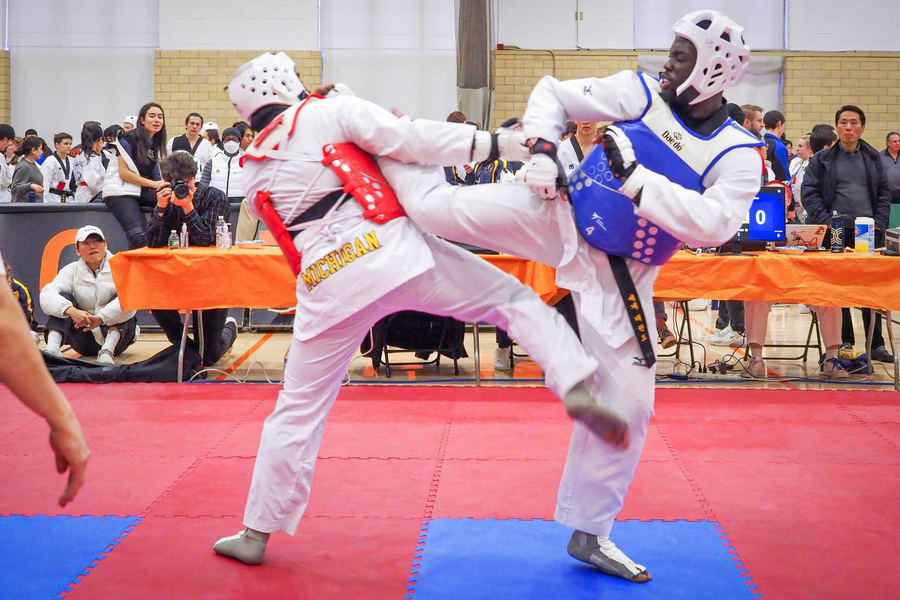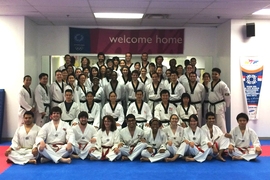Combat sports might not be the first thing that comes to mind when people think of MIT, but the MIT Sport Taekwondo Club has been attracting students as an outlet from the rigors of academic life for more than 20 years.
“The recurring thing we hear from graduating students in the club is that taekwondo is something that MIT students are allowed to be bad at and then learn to get better,” says head coach and instructor Dan Chuang.
“That’s important because high levels of performance are always expected for MIT students, but this is something they’re supposed to be bad at in the beginning,” he says. “In fact, they wear a white belt when they come in, and they’re allowed to climb the ladder of success one rung at a time. That process provides an environment where you can believe in your self-worth, not because someone else conferred it upon you or judged you worthy, but because you earned it yourself, piece by piece.”
Over the years, MIT students have earned a lot. The team, which is one of the largest club sports teams at MIT with about 100 members, has taken home six national championships and seven league championships since its formation in 2000, despite the fact that many members join without prior martial arts experience. In the most recent National Collegiate Taekwondo Championships in April, MIT students received medals in several categories.
More than the success, however, members of the team say the reason they stick around is the connections between team members. Those connections form through weekly practices, trips to tournaments, and the regular dinners and other social events hosted by the club. As a result, many members count their teammates as their closest friends, and it’s not uncommon for members to stay involved with the club for years after graduation.
“It’s my life — really,” says Moctar Fall ’22, MCP ’23, who was a co-captain of the club this past academic year. “I live, eat, and breathe it. I think the club has been my main foundation throughout my time as a student at MIT. I love the fact that there’s a chance for people to learn and grow throughout the club, and I love the community and competitive aspects of it.”
Many students described a similar path to taekwondo obsession. First, they joined Chuang’s course PE.0804 (Sport Taekwondo) to meet a requirement. Then they spent an extra hour practicing with the club team. Eventually, they went to a tournament to support their friends. Once they see a tournament, they’re hooked.
One such student is recent club president Jeffery Li ’23.
“I remember my first tournament clearly,” Li says. “Whenever people were sparring, the groups would erupt in cheers of encouragement. Everyone was so excited. That experience solidified that I wanted to join the club.”
Another co-captain from this year, Andy Lambert ’22, SM ’23, says the feeling of sparring is unlike anything he’s ever experienced.
“During matches the adrenaline is so high,” Lambert says. “If you’re fighting, the entire team is screaming for you to win and cheering every single point that might hit.”
Still, MIT Sport Taekwondo is not all combat. Practices and tournaments also feature Poomsae, which is a series of choreographed moves that teams perform together to improve their form and demonstrate their cohesion.
During the school year, the club holds three general practices a week and a sparring session on Saturdays. Captains also typically hold workouts on Sundays.
“It’s been a great break from classes,” says recent co-captain Claire Kim ’23. “I’d get to hang out with my friends, get in a good sweat, and go back and deal with problem sets. For the hour and a half of classes, you’re just focused on trying to get better and working your mind and body in a different way.”
Members said this year was a particularly tight knit team. Each group of students that joins as white belts develops skills together as they move through the ranks toward the black belt. The cohorts have their own handshakes and have even created their own mascots (stuffed animals) that get their own nicknames. Groups that have been training together for years may all test for their black belts at the same time.
“Everyone’s so close,” Li says. “During practice, we’d be kicking and punching each other. I think you have to be comfortable with the other people to do that.”
Overall, teammates say those bonds offer something unique at MIT.
“There’s nothing like the special relationship you form with the people you’re competing with,” Lambert says. “Coming to MIT, I had never done a team sport before. You become enmeshed into the club, and it’s really rewarding to relinquish your identity to an entity like a team. There’s just something special about that.”











